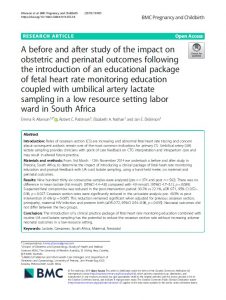
Introduction
Rates of cesarean section (CS) are increasing and abnormal fetal heart rate tracing and concern about consequent acidosis remain one of the most common indications for primary CS. Umbilical artery (UA) lactate sampling provides clinicians with point of care feedback on CTG interpretation and intrapartum care and may result in altered future practice.
Materials and methods
From 3rd March – 12th November 2014 we undertook a before and after study in Pretoria, South Africa, to determine the impact of introducing a clinical package of fetal heart rate monitoring education and prompt feedback with UA cord lactate sampling, using a hand-held meter, on maternal and perinatal outcomes.
Results
Nine hundred thirty-six consecutive samples were analyzed (pre n=374 and post n=562). There was no difference in mean lactate (4.6mmol/L [95%CI 4.4–4.8] compared with 4.9mmol/L [95%CI 4.7–5.1], p=0.089). Suspected fetal compromise was reduced in the post-intervention period: 30·2% vs 22·1%, aOR 0·71, 95% CI 0·52– 0·96, p=0·027. Cesarean section rates were significantly reduced in the univariate analysis: pre- 40·3% vs postintervention 31·6% (p=0·007). This reduction remained significant when adjusted for previous cesarean section, primiparity, maternal HIV infection and preterm birth (aOR 0·72, 95%CI 0·54–0·98, p=0·035). Neonatal outcomes did not differ between the two groups.
Conclusion
The introduction of a clinical practice package of fetal heart rate monitoring education combined with routine UA cord lactate sampling has the potential to reduce the cesarean section rate without increasing adverse neonatal outcomes in a low-resource setting.